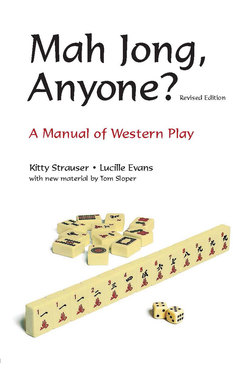Читать книгу Mah Jong, Anyone? - Kitty Strauser - Страница 7
На сайте Литреса книга снята с продажи.
ОглавлениеChapter 1
Equipment and Accessories
Western Mah Jong uses a set of 144 basic tiles. Extra tiles, if any, are not used in play. Accessories include four racks to hold the tiles while playing, counters to serve as money, dice, and a small container, such as a bowl, for the “kitty.”
When buying a Mah Jong set be sure that suit and flower tiles are clearly marked with numbers and that the wind tiles are lettered.
A standard card table is suitable for playing but should be covered, if it is hard-surfaced, to reduce noise when shuffling the tiles.
If you are a beginner, spread your set out as you read the following.
Tiles
Tiles, usually made of plastic, bone, bamboo, or sometimes ivory, are divided into three categories: (1) honor tiles, (2) suit tiles, and (3) flower tiles. Mah Jong sets vary a bit in their honor and flower tile markings, but these are readily distinguishable. The following illustrations are typical of current sets available in the market:
1. The honor tiles consist of:
| A. Four green dragons (may depict the green Chinese character “fa” or a green-colored dragon design, and sometimes marked with the letter “F”) | |
| Four red dragons (may depict the red Chinese character “chung” or a red-colored dragon design, and sometimes marked with the letter “C”) | |
| Four white dragons (may be blank or bear a blue rectangular design, and may sometimes be marked with the letter “B” or “P”) | A total of twelve tiles |
| B. Four east winds | |
| Four south winds | |
| Four west winds | |
| Four north winds | |
| A total of sixteen tiles |
2. The suit tiles consist of three different suits of 36 tiles each, numbered from 1 through 9, four of each number, making a total of 108 tiles. The three suits are:
A. Bamboos (also called sticks, bams, or boos)
B. Circles (also called dots or balls)
C. Characters (also called cracks)
The suit tiles numbered 1 and 9 are called terminals, have higher point value, and are considered honors; the suit tiles numbered 2 through 8 are called simples and have less point value.
3. The flower tiles (sometimes called seasons) consist of two sets of four tiles each, numbered 1 through 4, with one set marked in one color, the other in another color. (Some Mah Jong sets, however, contain one set of eight different flower tiles.) Flower tiles are not used in actual play but represent a bonus to the holder, as will be explained in the discussion of the game.
Add together the 12 dragon tiles, the 16 wind tiles, the 108 suit tiles, and the 8 flower tiles, and the total is 144 basic tiles.
Some Mah Jong sets contain extra tiles known as the Cat, the Rat, the Cock, the Worm, the Old Man, and the Bag of Gold, and/or four joker tiles. These tiles do not enter into the formation of a Mah Jong hand but are used by players who enjoy the zest they add to the game. Their use is explained on pages 21–23.
There are usually several extra plain white tiles in most Mah Jong sets. These are used as replacement tiles and can be marked to match a lost tile.
Racks
The racks, while not essential, are helpful in that they hold the tiles at an easily visible angle and also provide holders for the chips or counters.
Counters
Modern Mah Jong sets sometimes come with poker chips or smaller round chips shaped like Chinese coins, with holes in the middle to facilitate stacking on rack prongs. Older sets or some Asian sets come with counting sticks of bone or plastic with denominations indicated by dots in various number and/or color formations.
In this manual, all limits and scoring are based on a 10,000-point stake that each player receives at the start of the game. Counters are divided into four denominations as follows:
| Ten counters valued at | 10 | points each | 100 | points |
| Nine counters valued at | 100 | points each | 900 | points |
| Ten counters valued at | 500 | points each | 5,000 | points |
| Four counters valued at | 1,000 | points each | 4,000 | points |
| Total | 10,000 | points |
Other variations of counter distribution may be made, if desired. Before playing, stakes and limits to be paid should be determined. Counters too should be checked to assure accurate distribution. It is not necessary to put up money before beginning because, during the game, scores are settled through the exchange of counters.
If, however, a player loses all her counters during the game, she buys a new stake from any affluent player and, as a rule, pays cash to the seller.
Dice
A pair of dice is an essential accessory, as will be explained later.
Now that you beginners are familiar with your sets and accessories, let’s play a game of Mah Jong.
